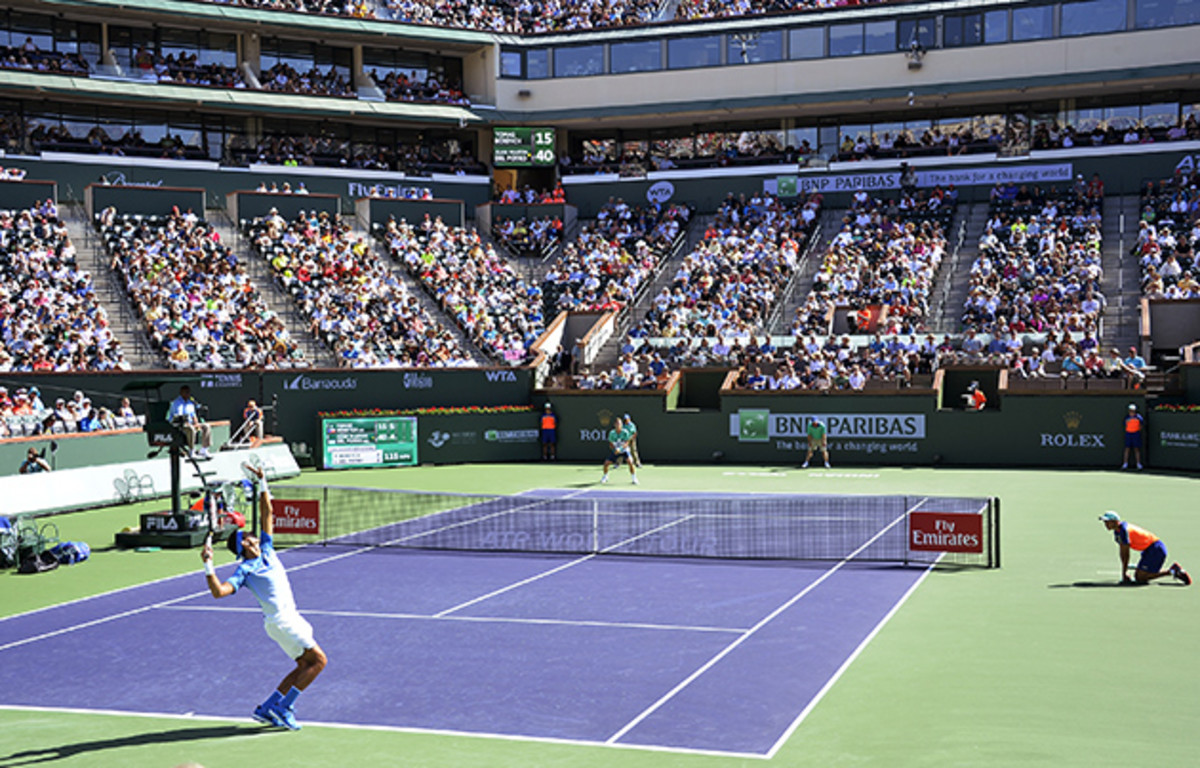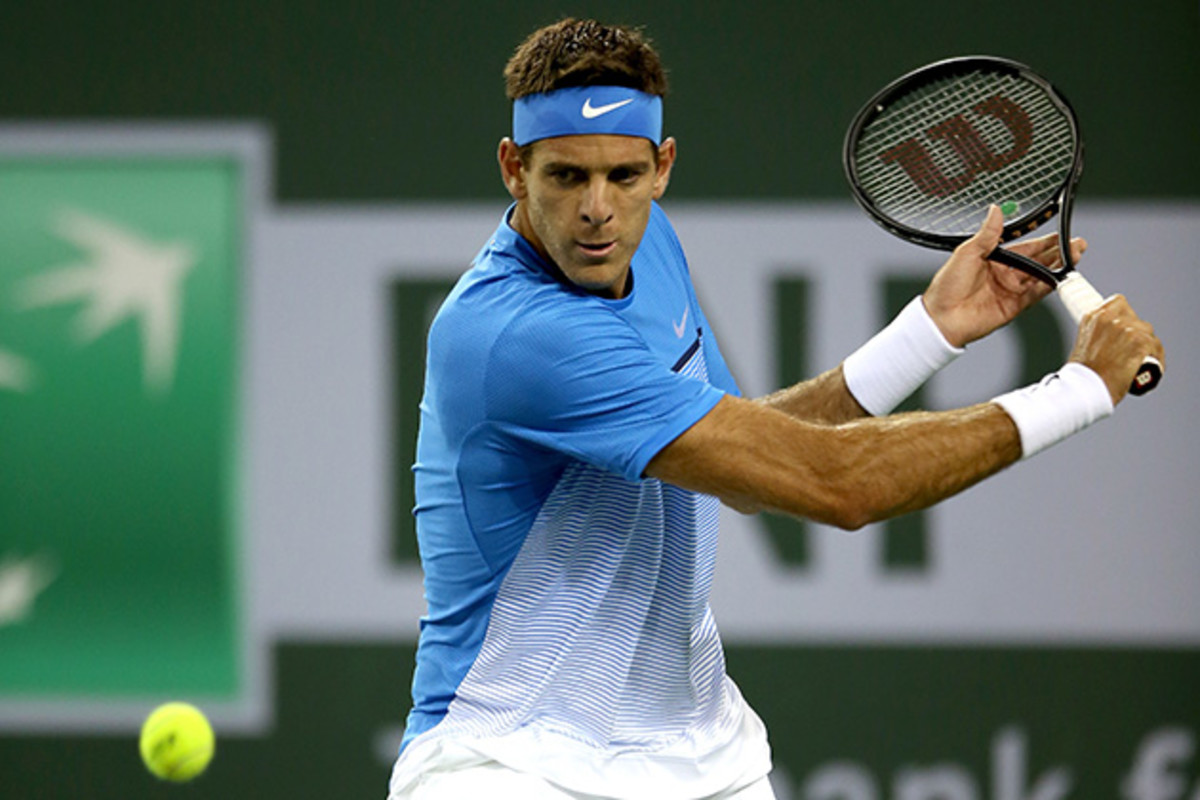Juan Martin del Potro recognizes challenges in latest comeback

The perpendicular scar on Juan Martin del Potro’s left wrist forms a perfect “T.” It illustrates, with poignant precision, the multiplying career forks faced by the former top-5 player from Argentina.
Nearly seven years have passed since del Potro upended Rafael Nadal and Roger Federer back-to-back to win the 2009 U.S. Open at age 20. The narrative-altering performance heralded a new force to be reckoned with in men’s tennis. But less than eight months later, he had surgery on his right wrist, the first of four wrist operations. The three others were on his non-dominant left hand, the most recent in June.
Now, the injury-plagued del Potro, 27, is again on the comeback trail. In an interview at the BNP Paribas Open in March—his second tournament in 11 months—the soft-spoken del Potro said he nearly quit.
But he couldn’t imagine an existence without tennis.

“It was my not my real life,” he said of the agonizing period last year when he returned to Argentina and contemplated retirement. “This is my life."
“I want to play tennis, and I don't care if I have to survive with these kind of pains or these backhands or slices. [I’m] just trying to do the most what I can, and that's it.”
A few weeks into his latest comeback, del Potro is showing that his fearsome forehand and fundamental court skills have not disappeared. Granted a wild card his first event back at Delray Beach, Fla., he notched three wins, including a straight-set defeat of No. 30 Jeremy Chardy, before falling to American Sam Querrey 7–5, 7–5 in the semifinals.
Djokovic beats Nadal to reach final at Indian Wells for third straight year
With another wild card at the BNP Paribas Open in Indian Wells, del Potro beat Tim Smyczek 6–4, 6–0 in the first round to set up his sternest test so far: a meeting with World No. 7 Tomas Berdych.
The 6’6” del Potro held his ground for the first set but faded in the second in a 7–6(4), 6–2 loss. He often relied on a sliced one-handed backhand during rallies, and ran around to hit forehands whenever possible.
Afterwards, the big-hitting Berdych praised the speed and heaviness of del Potro’s serve and forehand. “He has quite a few weapons he can work around,” Berdych said.
But Berdych conceded that del Potro still needed matches to gain rhythm and confidence. And he did not sound convinced that the Argentine could re-ascend to elite status by deflecting the ball with one hand from his backhand wing.
“These days it might be a bit more difficult with that,” said Berdych. “When you look at the top guys, there [are] no signs of weakness from any of the sides.”
After the match, del Potro agreed he is still progressing.
The SI Extra Newsletter Get the best of Sports Illustrated delivered right to your inbox
Subscribe
“I need to get my backhand again if I want to play the same conditions with these guys,” he said. “My wrist, I need stability in my wrist, more strength and flexibility, everything.”
Novak Djokovic clarifies comments on gender and pay allocation
It’s a long way from the nadir of 12 months ago, when he lost in the first round of the Miami Open to Canada’s VasekPospisil. Told he needed a third surgery on his left wrist, he returned to his native Tandil in a deep funk.
“I was depressed,” said del Potro.
He disassociated from tennis for three weeks, instead hanging out with family and friends who tried to boost his spirits. They barbecued. They went out. They drank cups of mate, the highly caffeinated tea popular in parts of South America.
All the while, del Potro measured his motivation for yet another comeback. His friends could see that his fire for the game was not extinguished, but they wanted to support his decision either way. del Potro thought seriously about stopping, but also felt the embers.

“When I fall asleep inside my mind something is telling me to try to do it once again,” he said. “Don’t give up,” the voice said.
He awoke one morning resolved to move forward and called his doctor in the U.S. to arrange a visit. The upshot: He could be back in 4–6 months after one more surgery. It was reasonable enough, del Potro figured, for another try. “I (didn’t) have too many options,” he said.
The months ahead were familiar: rest, rehab, then taking the court to hit only forehands and serves.
“Boring for sure,” said del Potro, but necessary steps.
40 parting thoughts from BNP Paribas Open in Indian Wells
It helped to hear from some of his peers by email and text. Among the well-wishers were Novak Djokovic, Roger Federer, Mardy Fish, James Blake and compatriot Leonardo Mayer, according to del Potro. He also was in contact with two of his country’s biggest soccer stars, Lionel Messi and Sergio Agüero.
For now, del Potro seems less concerned with deeper career questions. Has the game passed him by? Would he be satisfied if he can’t challenge for big titles? What constitutes success?
“I don’t care,” he said, brushing off the comparisons to his Grand Slam winning days. He is simply elated to be back at big tournaments in front of his fans.
“I don’t feel any pressure about rankings, about my level,” he said. “This is what I have today. The fans come and watch me. They know how I’m playing now. They are still coming. They want me to just play tennis and that’s amazing.”
His perspective makes sense. del Potro has been down this road before. He knows how to manage expectations of himself and the public. The forks have not been without success.
Indian Wells CEO Raymond Moore steps down
In between surgery-forced layoffs, del Potro has achieved new milestones, though a second major title remains elusive. He defeated Djokovic for a bronze medal at the 2012 Olympics. He reached his first Wimbledon semifinal in 2013. As recently as February 2014, he equaled his career-high No. 4 ranking. But after 18 career titles—the last at Sydney in 2014—early exits don’t sit well with the former Grand Slam champion.
“I usually go far in tournaments and (I’m trying) to win the titles,” he said. “It’s not easy to deal with.”
But in just two events in 2016 he has boosted his ranking from outside the top-1,000 to No. 366. Better yet, he has played six matches this month—more than all of last year—without pain.
He can expect a warm reception this week at the Miami Open in Key Biscayne, Fla., where South American players are often treated like hometown favorites. On Wednesday, he opens against No. 39 Guido Pella, the top-ranked man from Argentina, and could face No. 3 Federer, also returning from surgery on his knee, in the second round.
He is flying solo for the moment, having parted ways with his longtime coach and fellow Argentine Franco Davin after his most recent operation. del Potro reasons that it makes sense to see how his body responds before rebuilding his team. Meantime, he is traveling with a physiotherapist and working on overall fitness and the rehabilitation of his wrist, which requires two one-hour sessions per day.
Despite the aging demographics in tennis, Nadal, two years older at 29, said he wasn’t sure if del Potro could climb all the way back to the Grand Slam winner’s circle. But the 14-time major winner from Spain said his early form showed promise.
“[He’s] winning some great matches against tough players after a long time,” Nadal said this month. “It’s great to see such an important player for our tour coming back and playing well.”
